Natural Beauty Without The Fuss – Queen’s Wreath
Who doesn’t like Queen’s Wreath Vine? I have a renewed appreciation for my Queen’s Wreath Vine, also known as Antigonon leptopus. In the garden during the summer months it is fabulous. Now, I realize that there are some who do enjoy the satisfaction of working hard with their plants. The last thing I want to do is have to fuss over a plant in the middle of the summer heat so that it will look beautiful for me. I would much rather enjoy the ‘natural beauty’ of my summer plants looking through the windows from the comfort of my air-conditioned home.
Embracing the Beauty of Queen’s Wreath Vine
Earlier this summer, I wrote about one of my favorite ‘natural beauties’ in the garden, Yellow Bells. Today, I would like to introduce you to one of my favorite summer vines. It is a wonderful example of fabulous vine that is a ‘natural beauty.’
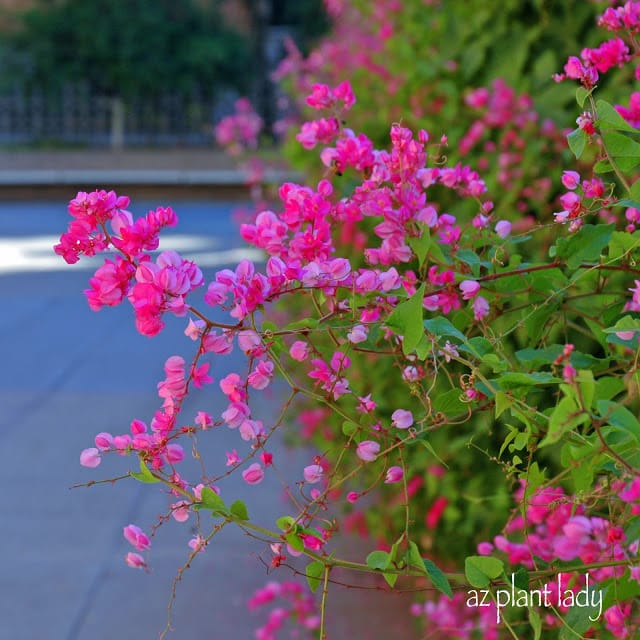
Queen’s Wreath vines grace the Arizona State University campus.
The Natural Charm of Queen’s Wreath Vine
Queen Wreath Vine (Antigonon leptopus) is a colorful asset to my garden. This ‘natural beauty’ is a vine that is native to Mexico and Central America. The vibrant vine graces your garden with stunning pink sprays of flowers that last from spring until the first frost. While it can be invasive in tropical areas, it’s easily managed in the desert climate.
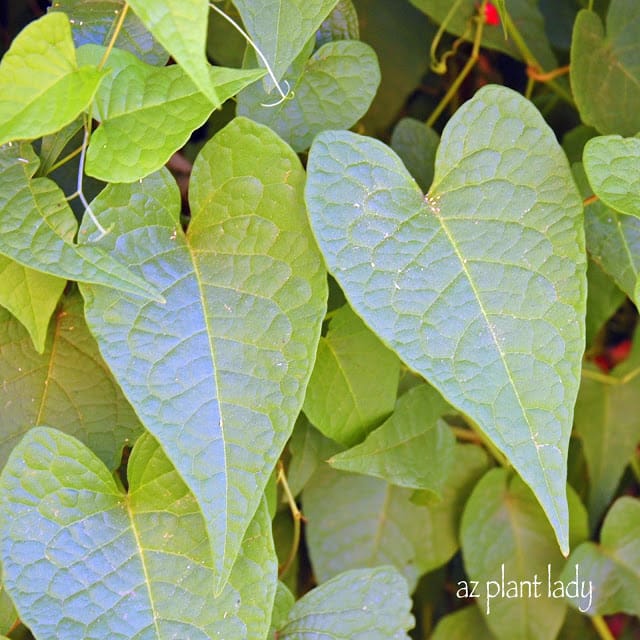
In our desert climate, they do require supplemental water, but no fertilizer is needed. Bees are attracted to the beautiful flowers, and I love the pretty heart-shaped leaves.
Queen’s Wreath is a robust vine. It can endure in full sun including areas of reflected heat. It will also grow in light shade although flowering will be reduced. The only maintenance required in my garden is pruning it back in winter once it dies back after the first frost. The roots are hardy to 20 degrees F, and in the spring, it quickly grows back with a trellis, fence or an arbor for support.

A wall of Queen’s Wreath Vine at ASU
The only consistent maintenance required in my garden is pruning it back in winter once it dies back after the first frost. However the roots are hardy to 20 degrees F, and in the spring, it quickly grows back with a trellis, fence or an arbor for support. See more in the mini-guide below
HOW TO GROW QUEEN’S WREATH VINE: A Mini-Guide
Step 1: Choosing the Ideal Location
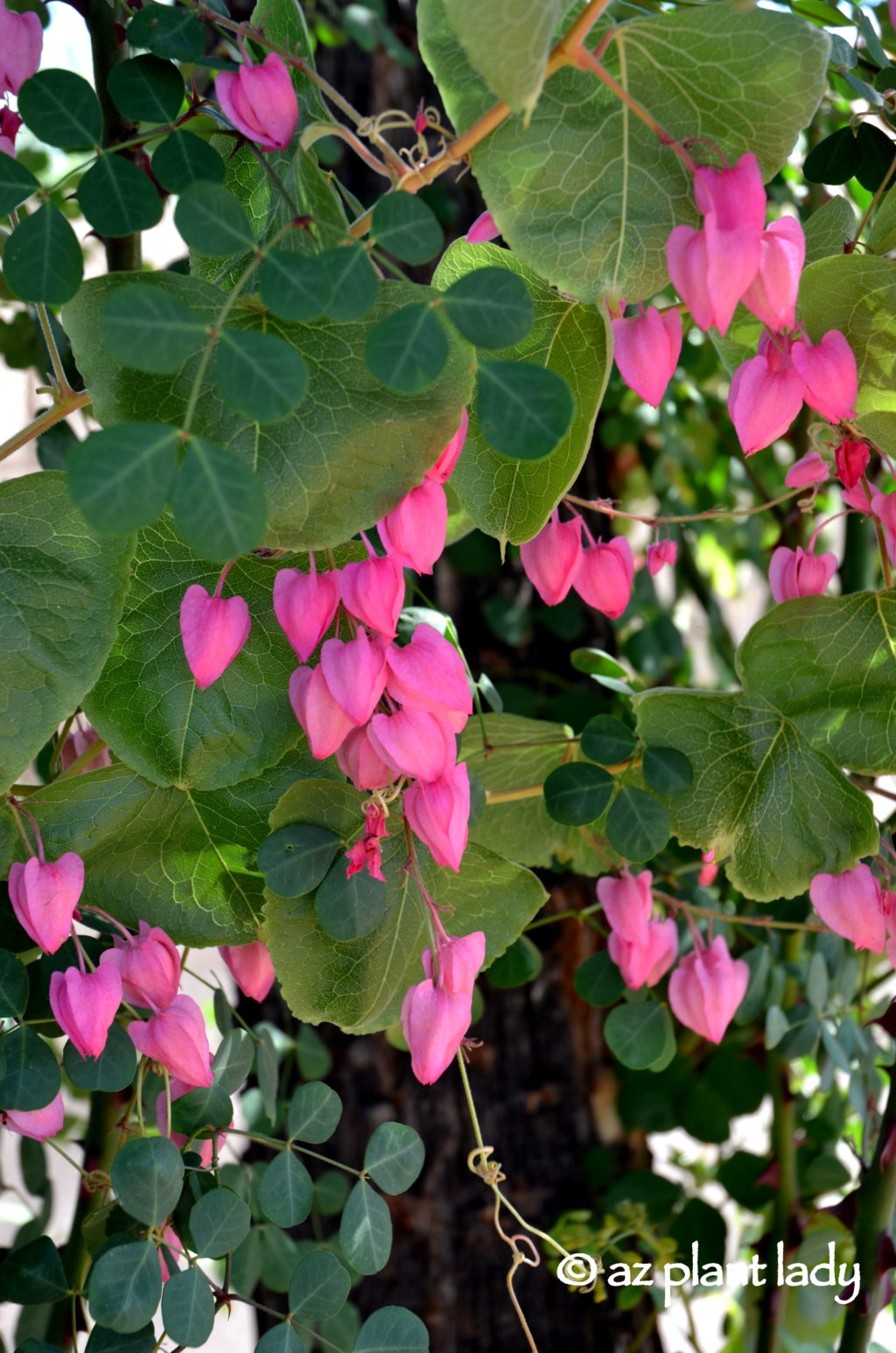
To successfully cultivate Queen’s Wreath Vine, select a sunny spot in your garden where it can bask in plenty of sunlight. While it can tolerate light shade, it thrives when exposed to full sun, making it an ideal choice for areas with reflected heat.
Step 2: Preparing the Soil
Ensure the soil is well-draining to prevent waterlogged roots. Queen’s Wreath Vine thrives in various soil types but benefits from enriched soil containing organic matter.
Step 3: Planting the Vine
Plant your Queen’s Wreath Vine near a trellis, fence, or arbor to provide the necessary support for its growth. Dig a hole deep enough to comfortably accommodate its root system.
Step 4: Proper Watering
While Queen’s Wreath Vine becomes drought-tolerant once established, it appreciates supplemental watering, especially during dry spells. Water deeply to encourage robust root development, but make sure the plant has good drainage.
Step 5: Pruning and Maintenance
In winter, after the first frost, prune any dead or overgrown branches to promote vigorous spring growth. Minimal maintenance will keep your Queen’s Wreath Vine flourishing year after year.
By following these steps, you can enjoy the ‘natural beauty’ of Queen’s Wreath Vine in your own garden without the fuss, and revel in its stunning pink displays throughout the year.
My first experience with queen’s wreath was in our first home in Phoenix, where there was a support made up of twine tied between two palm trees. We had no idea why it was there, but it sure looked ugly. Well, before we had time to remove the twine, beautiful, light green, heart-shaped leaves began climbing up the support and quickly covered it. Gorgeous sprays of pink flowers rapidly followed, which was a pleasant surprise.
What natural beauties are enjoying in your garden this month?
I will be sharing another favorite ‘natural beauty’ from my garden soon.

 Noelle Johnson, aka, 'AZ Plant Lady' is a author, horticulturist, and landscape consultant who helps people learn how to create, grow, and maintain beautiful desert gardens that thrive in a hot, dry climate. She does this through her consulting services, her online class Desert Gardening 101, and her monthly membership club, Through the Garden Gate. As she likes to tell desert-dwellers, "Gardening in the desert isn't hard, but it is different."
Noelle Johnson, aka, 'AZ Plant Lady' is a author, horticulturist, and landscape consultant who helps people learn how to create, grow, and maintain beautiful desert gardens that thrive in a hot, dry climate. She does this through her consulting services, her online class Desert Gardening 101, and her monthly membership club, Through the Garden Gate. As she likes to tell desert-dwellers, "Gardening in the desert isn't hard, but it is different."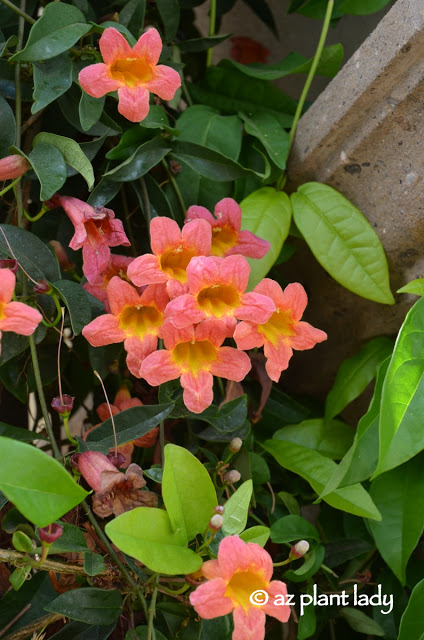
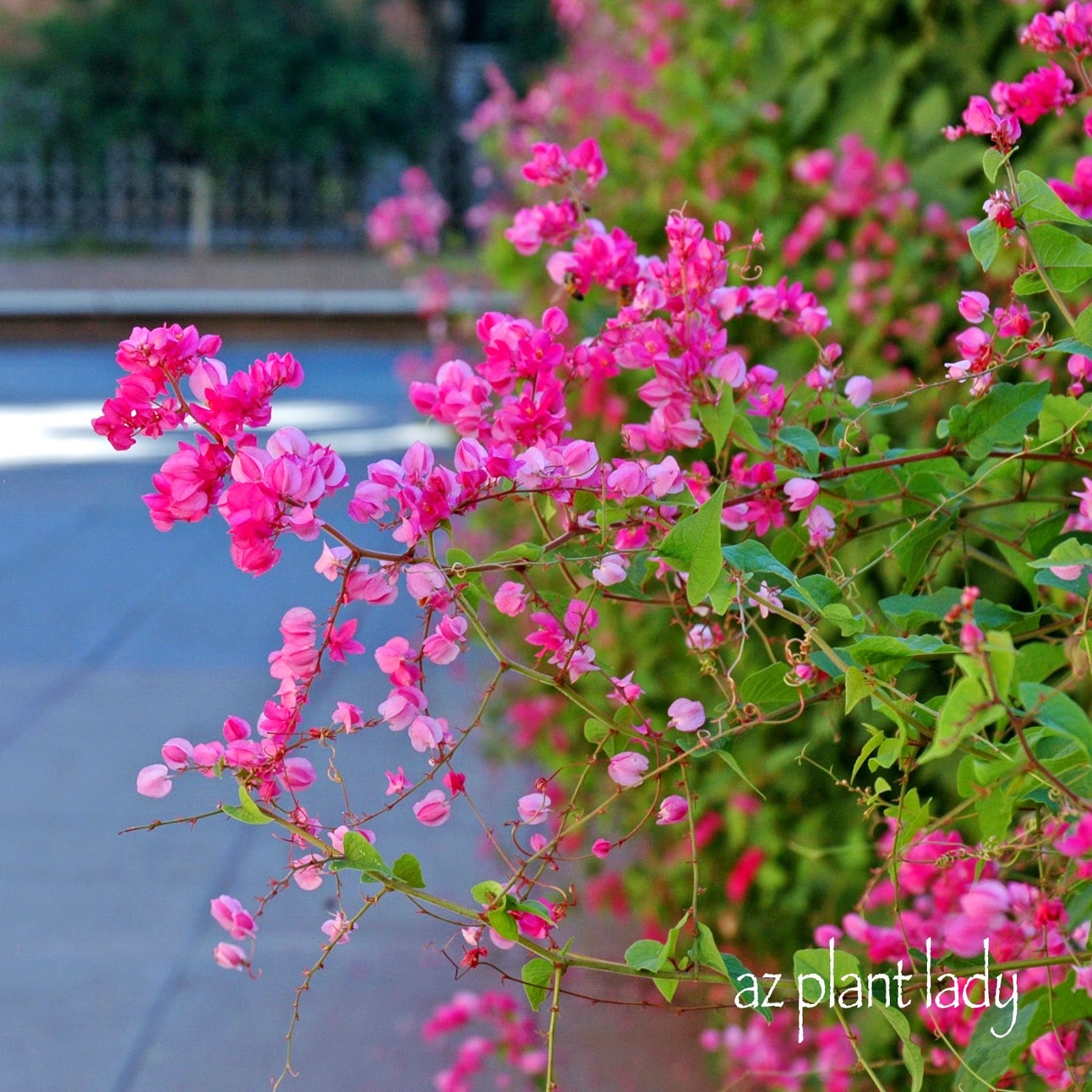
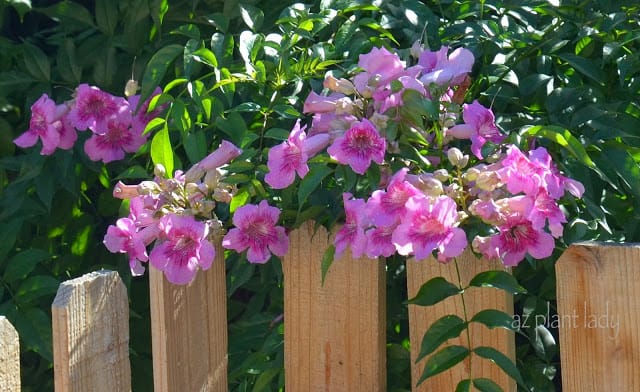

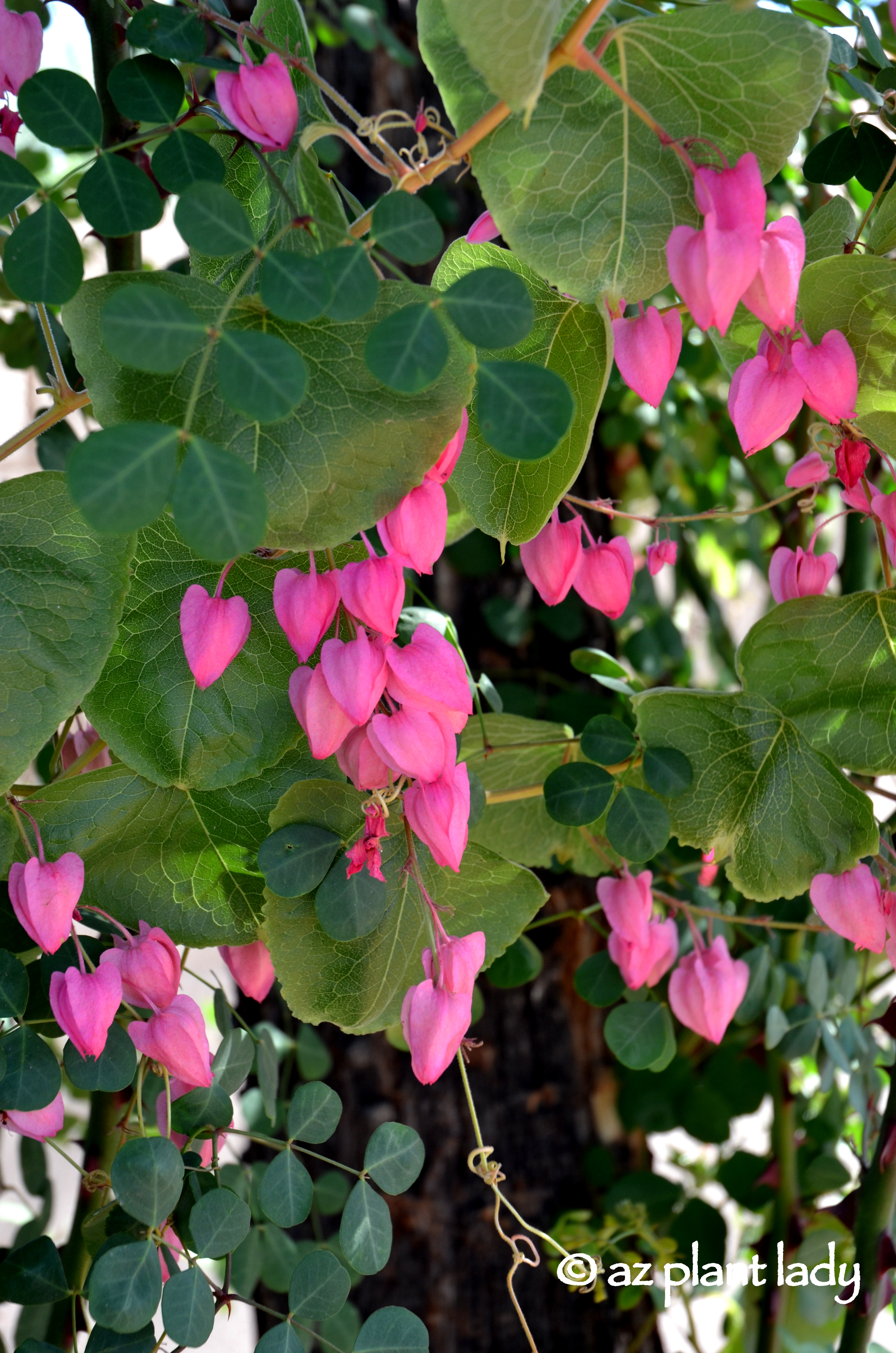
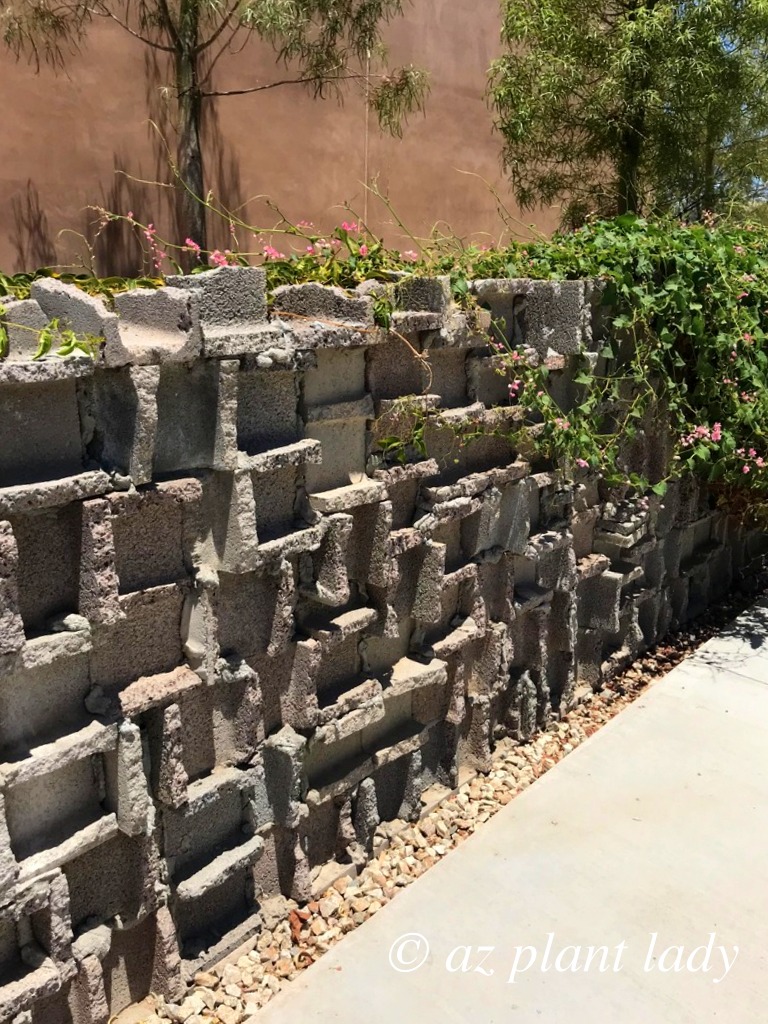








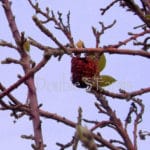

I'm afraid it wouldn't be hardy in my area, for most winters have a few days that plummet into the teens. Too sad! That is a beautiful vine. I think it might be worth growing as an annual.
This is so beautiful – and I can understand how you would appreciate it! (Your story of how you first discovered it was funny. It was certainly a wonderful surprise, wasn't it??) 🙂
What a beautiful plant, Noelle. When I created my blue and yellow border, I left the native goldenrod (Solidago) growing around the edges of that flower bed and also moved some of them into the flower bed. They are, indeed, trouble-free plants that don't need to be coddled or staked or watered on hot days. I think "natural beauties" is a great category for them. -Jean
I completely agree with you, about not working too hard in the summer heat.
We have Queen's Wreath here. Only, I learned it's name as Coral Vine. I bought one last fall, but it didn't make it through the winter. I guess it wasn't in the ground long enough, before the cold set in. They do seem to 'take over', though.
~~Linda…
Queen's Wreath vine is a lovely plant. I've never heard of it, but then it probably can't grow in Zone 5b. I do my gardening in the early morning, when the air is fresh and cooler and well…I'm fresh, too!
Have a wonderful evening.
I remember being pregnant in Texas with my first baby and just melting. We moved to the mountains to get away from that heat! Still I only garden in the early morning and night. The sun is still intense here in the afternoon. I like this wall of color you showed. And since it is low maint. it is even better feature!
That really is a beautiful vine! The color of the flowers is so pretty. The tough plants that were able to take the heat we had after such a cool wet start to summer are my natural beauties… Bee balm is one right now that doesn't seem to care what the weather is.
Wow, it's so exceptionally lovely!! It's great when you have the balance between invasive and pleasantly vigourous. Great post!!
What a beautiful climber! Wish we had something like it with that (for me new favourite) colour all through summer:-)
Like most Scandinavian people, I too enjoy a more "rustic" garden that sorts itself out on its own more or less… Summer is for leisure and play:-)
Greetings from a Fairytale Summery Sweden! Hillevi
What a great wall of pink. It is a beauty for sure.
She's a beauty, Noelle. Once again, I'm green with envy at your growing zone and it's ability to showcase such stunning flowers. 🙂
What a beautiful vine, Noelle! Anything that blooms from spring to first frost is a winner in my book as well. I'm all for natural beauties, too. I know it's not as hot here in the Midwest as it is in AZ, but still I can't get motivated to care for fussy plants when the summer heat makes it feel like a sauna outside. I'd have to say my natural beauties are coneflowers and black-eyed Susans–they reseed themselves and generally don't need any help from me whatsoever:)
We call that "coral vine" here in Florida, where it does indeed grow at an alarming rate. It's considered invasive, though not banned (yet). Our "Queen's Wreath" is a beautiful purple-flowering vine. My favorite natural beauties right now are the Florida Cracker Roses and the crapes. No worries. Just beauty.
I love the colours and those little bell flowers. Sadly, its invasive in my region and often times they somehow spring out here & there in some pockets of garden areas.
Have you manage to get the white variety of this type?
Absolutely beautiful flowers Noelle! I absolutely love the pink color and they must be quite a site to see in person. Your pictures are really incredible.
that is a beautiful vine and works so well in your environment, a little to invasive here in hawaii
my tis are my work horses here, when they get to tall, i just snap them down and stick the tops into the ground to make a new plant, no fuss 🙂
Noelle, The Queen's Wreath vine is stunning! There are no natural beauties quite that dramatic here. I haven't visited lately and just took a little time "catching up" on your news. I hope Kai is soon out of the wheelchair. Take care of that back – mine is "out" right now so I know how it feels. Pam x
How beautiful it is, Noelle! Thank you for introducing me to this lovely vine. I'm afraid it wouldn't be at all "natural" here — but maybe that's one of the lessons of natural beauty, to find out where you fit and thrive without too much fuss. 🙂
And a big thank you, Noelle, for your encouragement and for always being there with a kind word for me — and for so many others, too. Kindness and a joyful heart = my favorite kind of natural beauty. 🙂
yes Noelle, that really is invasive here so we dont plant it in gardens. There is even a white variety growing in the wild. Our former Metro Manila Commissioner in charge of order and beautification of highways planted it along main hiways, but they did not grow well in summer, maybe intolerant of car pollution. He thought that the invasiveness can be sustained in the Metropolis, now the trellises are being removed as eyesores. But yes, if properly controlled in gardens they are so beautiful. BTW, it is also found growing unabashedly n public cemeteries, which are not given proper attention, except during All Saints' Day!
I rip that vine out by the handful. It has a beautiful flower, but it grows over everything and is impossible to kill. Apparently, it was allowed to grow wild before I bought this house and with my cottage garden, I did not want the vine growing over all my flowers…It is horribly invasive. In a cooler climate, I can see how it would be very beautiful.
Even my morning glory, which I love, is invasive here. I yank it out all over the place, but keep it on my fence as the flowers are such a beautifully radiant purple…almost translucent.
Wow, it looks gorgeous en masse along the fence! We call it Queen's Crown in South Texas, where I grew up, and it is on the invasive side there. Now I can still enjoy looking at it when I visit my parents, before they rip it down every spring.
Hi Noelle…woah..I loove this..i would love to have this in my garden..gorgeous and magical..and such lovely airy blooms of color! Wonderful post!
Kiki~
Here they call it Coral Vine. The bees LOVE it. And I love it because it covers ugly chain link fences like a magic blanket.
Hi Noelle,
That is a really beautiful plant, and aptly named too. Very regal.
Thanks for sharing,
Suzanne
So beautiful! But I don't think it's hardy over here. Although we have +25-+30° celsius right now and it's like living in another climate, we can eat all meals outdoor, lovely!
Greetings from southern summer Sweden, Sophia
Thanks so much for this Queen's Wreath info. I've been looking for some for a while now for my own blog (Glory's Garden) and couldn't find anything usable. I just linked your article!
A Google search for "Queens' Wreath" returns lots of citations to a plant named Petrea Volubilis. However, you cite Antigonon leptopus. Which is the correct name? I want to be sure to get the right plant. Thanks.
Hello Maria,
The danger of using only common names to identify a plant is that many different plants can share a common name. That is why it is important to use scientific names in order to make sure you select the right plant.
In this case, Antigonon leptopus is the scientific name for the plant I wrote about. Petrea volubilis is a different plant.
I hope you enjoy your new vine 🙂
Noelle
I fell in love with Queen;s wreath the moment I saw it. Had to llok around to see which nursery carried it, i found it in Harper's. It is still in a pot but flowers have started to bloom.
Very Happy!
Just stumbled upon this article! I want to know what is the best time of year to plant this vine?
Hi Joshua,
Spring is the best time to plant one of these beautiful vines.
Sorry, I was mid-comment and I ether sent it or lost it completely. Sorry if this is a duplicate.
In this article you talking about cutting back the queens wreath every year. Does that mean all the way to the ground?
I always have a bunch of dead leaves at the end of the winter. Eventually, they get covered up by new growth. I am always afraid to cut them because I am worried that their is good stuff on the other end. (My adjacent citrus trees have lovely pink flowers flowing up the sides, even the 25-foot orange tree. Those flowers last through the winter, probably due to the warmth of the tree).
Hello Dave,
Great question! In zone 9 gardens, freezing weather usually kills most, if not all, of the above ground portion of the vine. You don’t have to remove it, but many people do as it isn’t particularly attractive. Either way is fine. I hope this helps.
I, too live in Arizona and love every minute of it. Love making my backyard my haven and am continuously looking for p,ants to make it better. I have recently been able to put a name to this beautiful vine, I past daily. Have been in hopes of finding this vine, but no luck. Can I get seeds or propagate this vine?
Hello BJ,
It can be hard to find queen’s wreath vine in regular nurseries and garden centers. Botanical garden sales are a good source and some specialized local nurseries may also carry them. It is worth adding to your backyard haven!
The flowering has subsided slightly, but here’s a shot of my Queen’s Wreath. The bees are all over this from 9 to 5 every day. No problems getting the veggies to pollinate.
https://photos.app.goo.gl/syzLGtXwF6HGZSR78
Simply stunning, Dave. Thank you so very much for sharing this!
Thanks. Here’s the whole place:
https://photos.app.goo.gl/XQgfQGj9P74rsNvr8
You’ll see some of your favorites.